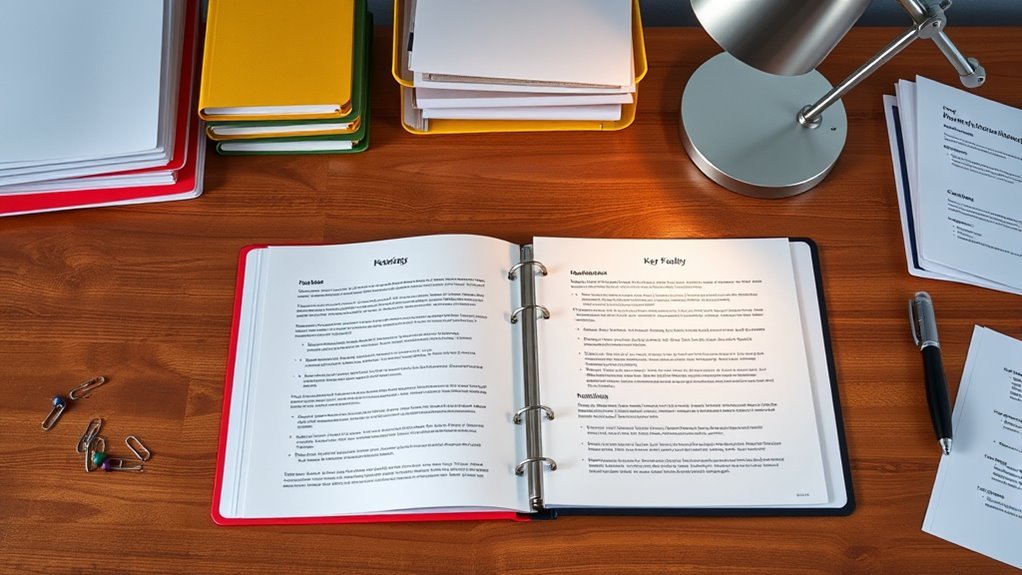How to Prepare a Hearing File and Supporting Documents
Preparing a hearing file in compliance with Indian laws and regulations entails organizing key documents such as original complaints, witness statements, and pertinent evidence. Begin by formulating a comprehensive table of contents to facilitate easy navigation through the materials. Ensure that all documents are formatted clearly, using appropriate font size and spacing to enhance readability.
Systematically compile your supporting materials and draft a succinct case summary that encapsulates the main points of your case, aligning with the relevant Indian legal framework. It is crucial to review the entire file meticulously to confirm that all information is accurate and presented professionally, adhering to the standards expected in legal proceedings.
Additionally, there are various strategies for effectively presenting your hearing file and improving your preparation techniques within the purview of Indian law.
Key Takeaways
- Gather all essential documents relevant to your case, including the original complaint, any pertinent correspondence, witness statements, and expert reports to compile your hearing file.
- Systematically organize your hearing file by implementing tabs and a detailed table of contents to facilitate quick navigation and enhance accessibility for all parties involved.
- Ensure that all documents are formatted consistently, utilizing a clear and legible font along with a structured layout to improve clarity and convey professionalism during presentation.
- Conduct a thorough review of the documents to verify the accuracy of their content, ensuring compliance with Indian laws and regulations prior to the hearing date.
- Prepare comprehensively for the presentation of your case, concentrating on the key arguments and practicing effective communication techniques to actively engage your audience.
Understanding the Importance of a Hearing File

A hearing file is crucial for anyone involved in legal or administrative proceedings in India. It serves as a comprehensive resource, ensuring that you have all the necessary information readily available.
Being well-prepared allows you to present your case more effectively, which can lead to more favorable outcomes. This file not only helps you remain organized but also enhances your confidence as you navigate through potentially stressful situations, such as court hearings or administrative reviews.
Being well-prepared boosts your confidence and ability to present your case effectively during hearings.
Having a structured approach makes it easier for you to address key points and respond to questions from judges, magistrates, or other decision-makers relevant to your case. Additionally, a well-organized hearing file showcases your diligence and professionalism, which can significantly influence the perception of your case among legal authorities.
Ultimately, dedicating time to create a comprehensive hearing file can be a transformative step in effectively advocating for your position within the framework of Indian laws and regulations. It empowers you to effectively present your arguments and facilitates a clearer understanding of the issues at hand. Moreover, being prepared for the hearing process, including anticipating questions from decision-makers, further boosts your confidence and helps you navigate the proceeding successfully.
Identifying Key Documents to Include
Preparing your hearing file requires careful consideration of the key documents you’ll need, especially within the context of Indian laws and regulations. Start by reviewing the specifics of your case, as they’ll guide you in selecting relevant materials.
Typical documents to include are the original complaint, responses from opposing parties, and pertinent correspondence.
Gather evidence such as witness statements, expert reports, and any photographs or videos that are relevant to your case. Additionally, be sure to include legal statutes, regulations, or case law that support your position, drawing from resources like the Indian Penal Code, Code of Civil Procedure, or any relevant judicial precedents.
It’s also crucial to include transcripts from previous hearings or rulings that may have bearings on your case. Furthermore, consider incorporating a comprehensive timeline of events to provide context for all parties involved.
These documents will help fortify your argument and ensure that you’re adequately prepared for the hearing as per Indian legal standards. A structured approach to legal due diligence will also enhance your understanding of potential risks associated with your case.
Organizing Your Hearing File Effectively

When organizing your hearing file in accordance with Indian laws and regulations, it’s crucial to start with an essential documents checklist to ensure that all necessary legal documents are accounted for. This may include notices, replies, and any relevant court orders.
Following that, categorizing your supporting evidence is key in establishing a coherent structure. This method allows you to group documents such as witness statements, expert reports, and any other pertinent information effectively.
Lastly, make sure to organize your digital files in a manner that ensures all documents are readily accessible when needed, particularly in compliance with data management regulations in India.
Essential Documents Checklist
An essential step in organizing your hearing file under Indian laws and regulations is creating a thorough checklist of necessary documents.
Start by listing your primary documents, such as the hearing notice, relevant legal statutes, and your case summary.
Don’t forget to include identification documents, like your Aadhaar card or passport, as these may be required.
Next, note any witness statements or expert reports that support your case.
It’s also prudent to gather any correspondence with the relevant parties, including emails and letters.
Additionally, ensure you have all your evidence, such as photographs or diagrams, neatly organized.
This checklist won’t only save you time but also help guarantee you don’t overlook vital materials needed for a successful hearing under Indian law.
Categorizing Supporting Evidence
Categorizing your supporting evidence is crucial for maintaining an organized hearing file that’s easy to navigate within the framework of Indian laws and regulations.
Begin by grouping your documents into relevant categories, such as witness statements, expert affidavits, and legal precedents applicable to Indian law. Each category should have its own distinct section, making it straightforward to locate specific information when required.
Consider labeling each section clearly to enhance visibility. You might utilize tabs or color coding for additional clarity.
Prioritize your evidence based on its significance and relevance to the case, placing the most critical documents at the forefront of each section.
Lastly, ensure that your categorization remains consistent throughout, enabling anyone reviewing your file to quickly grasp and access the information. This method not only saves time but also strengthens your overall presentation in adherence to the norms of the legal process in India.
Organizing Digital Files
To ensure your hearing file is effective under Indian laws and regulations, it’s crucial to organize your digital files systematically.
Begin by creating folders for various categories—such as case documents, evidence, and correspondence. Clearly label each folder to facilitate easy navigation.
Within these folders, use subfolders to distinguish between types of documents, like witness statements, expert reports, or affidavits.
It is advisable to save documents in a consistent format, such as PDF, to maintain their integrity. Moreover, back up everything in the cloud or on an external drive to prevent any potential data loss.
Additionally, regular compliance assessments help identify potential risks and gaps in policies and procedures to ensure organizational integrity. Lastly, maintain a clear and concise file naming convention, incorporating dates and relevant keywords. This organized approach will save you time and alleviate stress as you prepare for your hearing in compliance with Indian legal standards.
Formatting Your Documents for Clarity

While preparing your hearing file under Indian laws and regulations, it is essential to ensure that your documents are easy to read and understand. A clear layout significantly aids in conveying your message effectively. Here are some formatting tips to evaluate:
| Formatting Element | Best Practice |
|---|---|
| Font Size | Use 12-point |
| Font Type | Choose Arial or Times New Roman |
| Line Spacing | Set to 1.5 or double |
| Margins | 1-inch on all sides |
| Headings | Use bold and larger size |
Consistent formatting enhances readability. Avoid clutter and use bullet points or numbered lists to break down information. Remember, clarity is key to making your hearing documents impactful and accessible, especially when navigating the complexities of Indian laws and regulations.
Creating a Table of Contents
A well-organized hearing file in the context of Indian laws and regulations should include a Table of Contents (TOC) that guides readers through your documents effortlessly. By creating a TOC, you ensure that all parties can quickly locate the materials they need in accordance with relevant stipulations under Indian law.
A well-structured Table of Contents is essential for navigating legal documents effectively in Indian law.
Start by listing each section title along with its corresponding page number, ensuring it reflects the legal framework and requirements applicable to your case. Utilize clear, concise language, avoiding jargon that could confuse readers unfamiliar with legal terminology.
Consider employing numbered headings for easy reference, which lends a professional and polished look to your TOC. After drafting your TOC, it’s essential to double-check that all page numbers are accurate and that the titles align with the actual documents, in line with procedural rules outlined under Indian judicial practices. Additionally, maintaining these documents enables transparency and accountability, much like the way meeting minutes serve in corporate governance.
A well-structured TOC is critical for efficiency and demonstrates your attention to detail, ultimately enhancing the overall presentation of your hearing file within the legal framework of India.
Preparing Witness Statements and Affidavits
When preparing witness statements and affidavits within the context of Indian laws and regulations, their significance can’t be overstated.
It’s essential to focus on drafting effective affidavits that clearly articulate the facts and bolster your case. In India, affidavits must be in a prescribed format, sworn before a competent authority, and should comply with the relevant provisions of the Code of Civil Procedure, 1908, as well as the Indian Evidence Act, 1872.
Additionally, organizing supporting evidence alongside these documents will enhance your overall case presentation in court, making it critical to build a comprehensive and well-structured hearing file that aligns with legal requirements.
Importance of Witness Statements
When building a strong legal case within the framework of Indian laws and regulations, the significance of witness statements can’t be emphasized enough.
These statements provide crucial firsthand accounts that enhance the credibility of your argument and substantiate key facts. Witness testimony can also bridge gaps in evidence, offering a more comprehensive understanding of the events in question.
Engaging witnesses who possess relevant information not only bolsters your stance but can influence the decision-maker by presenting a unique perspective.
Furthermore, well-crafted, clear, and concise witness statements can preemptively address opposing arguments, thereby reinforcing your narrative effectively.
As you prepare your case, it’s essential to meticulously collect, document, and organize these witness statements.
They can play a pivotal role in fortifying your position and increasing the likelihood of a favorable outcome.
Paying attention to this critical aspect of your case is vital in navigating the complexities of the Indian legal system.
Drafting Effective Affidavits
Witness statements are commonly documented in the form of affidavits, which serve as legally binding declarations made under oath according to Indian laws.
When drafting an effective affidavit in India, begin with a clear introduction that includes the affiant’s name, address, and occupation. Use straightforward language to convey the facts; avoid jargon or overly complicated terms to ensure clarity.
Each statement should be concise and relevant to the case, providing necessary details without superfluous information. It’s crucial to remain objective and adhere strictly to the facts, as personal opinions can undermine the affidavit’s credibility.
Additionally, ensure that the affidavit is signed and duly notarized, as this reinforces its validity under Indian law. By following these guidelines, you can create affidavits that effectively support your case in a legal context.
Organizing Supporting Evidence
To effectively organize supporting evidence within the framework of Indian laws and regulations, it’s crucial to prepare witness statements and affidavits in a methodical and clear manner.
Begin by identifying the specific facts that each witness can present in accordance with the relevant legal provisions. Draft statements that encompass important details such as the witness’s background, expertise, and the relevance of their testimony to the case at hand. Each statement should be concise, focusing strictly on factual information while steering clear of unnecessary opinions.
When preparing affidavits, adhere to a structured format that includes a heading, an introductory statement, and a conclusion. It’s advisable to number or label each section for ease of reference.
Always ensure that witnesses review their statements for accuracy prior to submission. Lastly, maintain the organization of all witness documents—whether in a digital folder or a physical binder—ensuring they’re easily accessible during any legal proceedings.
This meticulous organization is essential under Indian legal practices to uphold the integrity and clarity of the evidence presented.
Compiling Relevant Evidence and Exhibits
Compiling relevant evidence and exhibits is an essential step in preparing your hearing file in line with Indian laws and regulations. Start by identifying all documents or items that support your case. This may include contracts, emails, photographs, affidavits, and any other pertinent records as outlined by the relevant legal provisions.
Ensure that you gather original documents whenever possible, as they’re typically given more weight in legal proceedings.
Once you have collected all necessary materials, organize them systematically to guarantee easy access during the hearing. You may use tabs, labels, or color-coding to differentiate between various types of evidence or themes related to your case.
It’s also important to create multiple copies of everything for distribution to your legal team or other relevant parties. This comprehensive preparation not only bolsters your argument but also reflects your diligence and readiness in the eyes of the presiding officer. Remember, understanding the specific nature of the penalties is crucial to building a strong case and effectively navigating the adjudication process.
Drafting a Clear and Concise Summary of Your Case
While you may have gathered substantial evidence, drafting a clear and concise summary of your case is essential for effectively communicating your argument at the hearing under Indian laws and regulations.
This summary should encapsulate your main points and provide context for the evidence you’ve collected. To achieve this, focus on the following elements:
- Case Background: Briefly outline the situation leading to the hearing, considering applicable Indian legal frameworks.
- Key Issues: Identify the central issues that need resolution, referencing relevant statutes or legal precedents where appropriate.
- Supporting Evidence: Highlight critical pieces of evidence that strengthen your argument and are admissible under Indian law.
- Conclusion: Clearly summarize what you seek from the hearing, ensuring that your desired outcome aligns with legal provisions and possible remedies under Indian law. Moreover, having professional representation during the hearing can significantly enhance the chances of achieving a favorable outcome.
Best Practices for Presenting Your Hearing File
When presenting your hearing file in the context of Indian laws and regulations, having a clear and organized approach is crucial for effectively conveying your argument. Begin by arranging the documents in a logical order that aligns with the structure of your case, which will facilitate understanding for the audience.
Utilize tabs or dividers to differentiate between various sections, allowing for quick access to specific information when needed.
While speaking, ensure that you maintain eye contact with your audience and use your file as a supportive reference, rather than reading verbatim from it. This approach not only enhances your confidence but also establishes your credibility.
Clearly summarize key points of your argument, and be prepared to respond to questions that may arise related to your materials and the applicable laws.
Moreover, it’s essential to practice your presentation thoroughly to ensure smooth delivery and appropriate timing. This preparation will help you remain calm and composed throughout the hearing.
Reviewing and Finalizing Your Hearing Preparation
As you conclude your hearing preparation, it’s crucial to meticulously verify the accuracy of all your documents in accordance with Indian laws and regulations.
Ensuring that everything is orderly and easily accessible during the hearing is vital for a smooth process. A well-structured file can significantly enhance your effectiveness in presenting your case, reinforcing your arguments and promoting clarity in the eyes of the adjudicating authority.
Double-check Document Accuracy
Before you present your case in an Indian legal setting, it’s crucial to ensure that all documents are accurate and complete. Accuracy can significantly impact the outcome of your hearing, so take the time to carefully review everything.
Here are four steps to ensure your documents meet these standards:
- Verify Dates: Check all dates for accuracy and relevance as per the Indian legal framework.
- Cross-reference Information: Ensure names, addresses, and case details are consistent across all documents in accordance with Indian regulations.
- Confirm Signatures: Verify that any required signatures are present and legible, complying with the legal requirements of your jurisdiction.
- Review Legal Language: Look for clarity and correctness in any legal jargon or terminology used, making sure it aligns with Indian legal precedents and terminology.
Taking these steps will give you confidence in your documentation while minimizing the chance for errors during the hearing.
Organize for Easy Access
Organizing your hearing file effectively is crucial for ensuring you can access information quickly during legal proceedings in India.
Begin by grouping documents logically—consider segmenting them by topic, date, or witness.
Utilize tabs or labeled dividers for straightforward navigation through your files. Additionally, create a table of contents to easily locate each document and its relevance to the case.
Place high-priority materials, such as written submissions and crucial evidence, at the front of your file. This strategy will prevent you from spending unnecessary time searching for key documents when they’re needed most.
It’s also advisable to maintain a digital backup of your files, which can be conveniently stored on a tablet or computer for quick access.
Finally, take some time to review your organizational strategy before the hearing. Familiarizing yourself with your file layout will significantly enhance your confidence and efficiency during the proceedings.
Questions
How Do I Choose Which Documents to Prioritize?
Don’t stress too much about achieving the perfect selection of documents in the context of Indian laws and regulations. Focus on prioritizing documents that directly support your main argument first. This could include legislation, case law, or regulatory guidelines that underpin your claims. After that, consider including documents that provide essential context or address potential counterarguments, such as alternative legal perspectives or opposing judgments. By prioritizing relevance in relation to the legal framework, you will significantly strengthen your case.
Can Electronic Files Be Included, or Only Physical Documents?
You can include electronic files in your submissions, provided they are easily accessible and properly organized. It is important to ensure that all files are in a compatible format as specified by Indian laws and regulations for the hearing. Clarity and ease of understanding are paramount, so make sure that all documents, whether electronic or physical, meet these requirements.
What Is the Typical Timeline for Preparing a Hearing File?
Most hearing files under Indian laws require approximately 4-6 weeks for preparation. This period is essential for gathering relevant documents, reviewing them comprehensively, and ensuring everything is organized in accordance with legal requirements. It’s also advisable to allocate additional time for any unforeseen delays that may occur during this process.
Are There Any Formatting Guidelines I Should Follow?
Regarding formatting guidelines for writing articles on Indian laws and regulations, adhere to the following advice:
- Clear Headings: Use descriptive headings to organize your content, making it easier for readers to navigate through different sections.
- Consistent Font Styles: Maintain uniformity in font styles throughout the document, selecting easily readable fonts to enhance clarity.
- Appropriate Margins: Set adequate margins to ensure that the text is not too cluttered, allowing for a clean and professional appearance.
- Logical Organization: Arrange documents in a logical order, aiding reviewers in quickly locating information. This includes number sequencing where applicable to enhance flow.
Who Can Assist Me in Preparing My Hearing File?
Your lawyer is typically the best resource for preparing your hearing file under Indian laws and regulations. For example, in a case similar to Maria’s, her attorney assisted her in gathering relevant evidence and systematically organizing her documents. This thorough preparation ensured that she felt confident and ready for the hearing day, understanding the nuances of Indian legal procedures and requirements.






